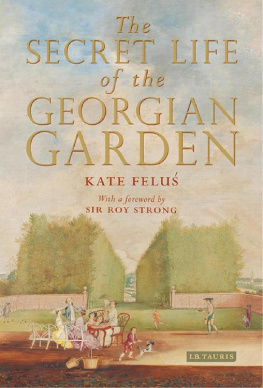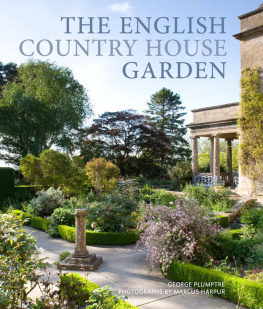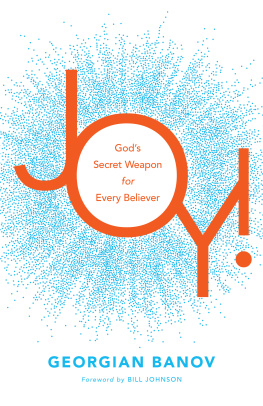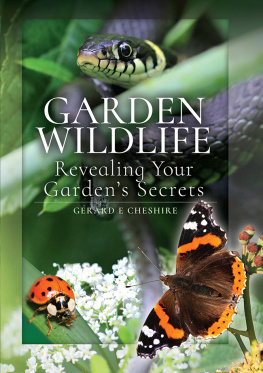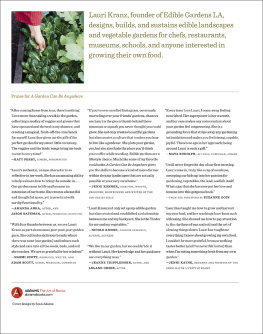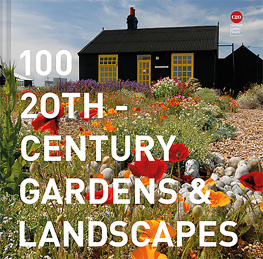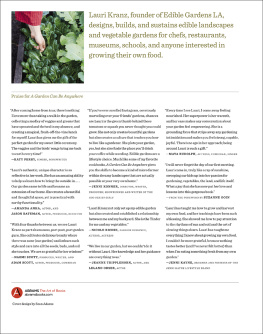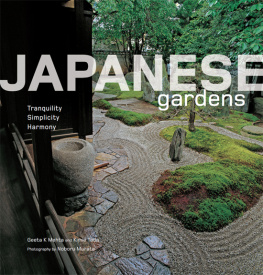KATE FELU is a garden historian and historic landscape consultant. She researches and writes about designed landscapes of all periods, specialising particularly in eighteenth- and early nineteenth-century parks and gardens.
In these pages the gardens of William Kent, Capability Brown and Humphry Repton spring to life. So along the paths we glimpse people from the great house walking or sweeping by in their carriages. Boats in the guise of men owar or Chinese junks take them on pleasure trips on Capabilitys newfangled lakes. On the banks they can be spotted fishing rod in hand or, if water takes a more covert role, they might be caught swimming stark naked in a cold bath.
SIR ROY STRONG
Kate Felu has unmasked the Georgians caught them in their garden indulgences, fabulous beyond the realms of even their clothes or their interiors.The book is wittily scripted through morning, noon and night, with fascinating illustrations, many rarely seen.
JANE BROWN, author of The Pursuit of Paradise and Lancelot Capability Brown: The Omnipotent Magician, 17161783
The
SECRET LIFE
of the
GEORGIAN
GARDEN
BEAUTIFUL OBJECTS & AGREEABLE RETREATS
KATE FELU

For my parents,
Gillian and Anthony Felu
Published in 2016 by
I.B.Tauris & Co. Ltd
London New York
www.ibtauris.com
Copyright 2016 Kate Felu
The right of Kate Felu to be identified as the author of this work has been asserted by the author in accordance with the Copyright, Designs and Patents Act 1988.
All rights reserved. Except for brief quotations in a review, this book, or any part thereof, may not be reproduced, stored in or introduced into a retrieval system, or transmitted, in any form or by any means, electronic, mechanical, photocopying, recording or otherwise, without the prior written permission of the publisher.
Every attempt has been made to gain permission for the use of the images in this book. Any omissions will be rectified in future editions.
References to websites were correct at the time of writing.
ISBN 978 1 78453 572 8
eISBN 978 1 78672 007 8
ePDF 978 1 78673 007 7
A full CIP record for this book is available from the British Library
A full CIP record is available from the Library of Congress
Library of Congress Catalog Card Number: available
Designed and typeset in Monotype Fournier by illuminati, Grosmont Printed and bound in Sweden by ScandBook AB
Contents
TWOSetting the Scene
Georgian Landscapes and Georgian Life
THREEMorning
Tours Refreshments en route Boating Bathing
FOURAfternoon
Fishing Study Curiosity Amorous LiaisonsGames & Recreation
FIVEEvening
Food Drink Music
SIXThe Night-time
Moonlight Ftes Illuminations Fireworks
Acknowledgements
O NE SUMMERS DAY in the final year of the last millennium, I sat on the rear seat of a coach heading back to York after a day at Castle Howard. I had just met Professor Timothy Mowl and on that journey we discussed the question of how the Georgians actually used their gardens. He suggested that it would make a suitable subject for a Ph.D. thesis, and that is how this book began. It is therefore fitting that my first acknowledgement is to Professor Mowl, my supervisor and friend; I thank him for his patience, generosity and regular wise counsel. Also at the University of Bristol, Michael Liversidge has always been encouraging, and I am grateful to the GNS Foundation for funding my studies there.
Living at Stowe was an invaluable experience and thanks must go to all my friends from that period, for helping to recreate goings-on in the garden, from sailing on the lake to music in the temples. My next debt is to Nick Owen and John Phibbs for teaching me to read landscape, to really understand how it worked, and for their unstinting generosity with nuggets of evidence and the benefit of their long experience in analysing Georgian parks and gardens.
The evidence on which this book is based comes from a wealth of disparate sources, and that is reflected in the length of the list of people to whom I owe a debt. No matter how seemingly small or insignificant, their contributions have been invaluable and I am grateful to them all: Rosemary Baird, Andrew Barber, Harry Beamish, Ian Berry, Michael Bevington, Ray Biggs, Simon Bonvoisin, Kate Bostock, Jane Bradney, Jane Brown, Cynthia Gaskell Brown, Mike Calnan, Penelope Cave, Jane Clark, Alexia Clarke, Adrian Cook, Abigail Coppins, Fiona Cowell, Rachel Cowgill, Mike Cozens, John Culver-house, Mel Czapski, Stephen Daniels, Duncan Davidson, Ivan Day, Steve Desmond, Jo Dixon, Andrew Eburne, Caroline Egar, Patrick Eyres, John Forster, Amy Forster-Smith, Basia Furmanik, Susan Gordon, Andrew Hann, Elain Harwood, Sandy Haynes, Clare Hickman, Matthew Hirst, Christine Hiskey, Gareth Hughes, Sally Hughes, Phil Hudson, Kate Johnson, Sir Henry Keswick, Elizabeth Knight, Tim Knox, David Lambert, Kim Legate, Karen Lynch, Richard Mabey, Ian Mackintosh, Laura Mayer, Jennifer Meir, Joanna, Ned and Clare Mersey, Susan Middlemas, Mark Newman, Richard Oldfield, Tom Oliver, Francesca Orestano, Elizabeth Owen, James Peill, Jill Plater, Martin Postle, Cristiano Ratti, Jean Reader, Michael Richardson, Michael Rudd, Sarah Rutherford, Sue Shephard, Steffie Shields, David Standing, Caroline Stanford, Mike Sutherill, Michael Symes, Peggy Synge, Nick Tomlinson, Martin Towsey, Gary Webb, Richard Wheeler, John White, James Collett-White, Liz Whittle and Tom Williamson.
Additionally, I am grateful to the search room staff at the Bedfordshire and Luton Archive; the West Devon Record Office; the Somerset Record Office; the Buckinghamshire Record Office; the West Sussex Record Office; and the Henry E. Huntington Library. Also the librarians at the Somerset Local Studies Library; the National Monuments Record; the staff in the Rare Books, Manuscripts and Map Rooms at the British Library; the librarians of St Johns College Library, Cambridge; the West Sussex library service for their county store, the rich depths of which I have regularly plundered; and the ever-helpful staff at my local library.
Particular thanks for numerous contributions also go to Dianne Barre, Oliver Jessop, Philip White and Min Wood, who when the mountain of my Ph.D. seemed unsurmountable persuaded me not to give up. I am grateful to Jenny Simmons, Cees Roos and Kay Morgan for reading early drafts; to Mike Kleyn and Susan Campbell for their encouragement, hospitality and wisdom; and to Jane Crawley for helping me to see how an up-cycled Ph.D. thesis could work as a book. Thanks to everyone at I.B.Tauris, especially my editor, Philippa Brewster, for her patience and enthusiasm for the subject.
For helping me to keep at least one foot in the present and real life while I was writing, I am grateful to Fiona Barrett, Louise Dignand and Rosie Simmons, and to their families for taking in my refugee children. Sue Slade, my parents Gillian and Anthony Felu and my sister Aime have all been a constant support. My final debt is to those closest to me, my sons Hal and Ivo, who have tolerated this cuckoo in their nest, and to Jon Edgar, sometimes frustrated but always supportive, who has still managed to plough his own furrow, while enabling me to plough mine.
Foreword
I T IS FORTY YEARS since the publication of Mark Girouards landmark book Life in the English Country House. In the preface the author wrote:
Even the most knowledgeable country-house enthusiasts tend to think in terms of architects, craftsmen or family history, but to know surprisingly little about how families used the house which the architects and craftsmen built for them.
Next page
